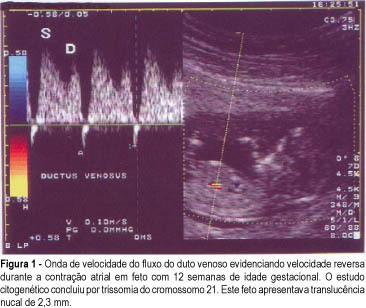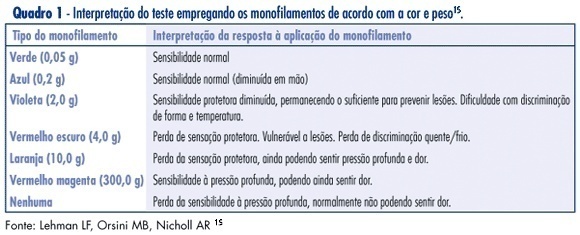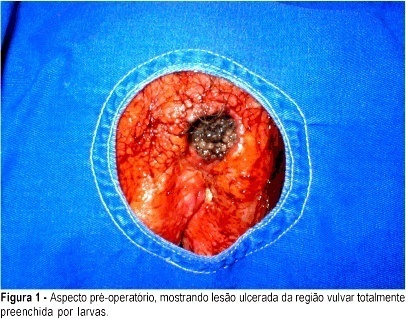Summary
Revista Brasileira de Ginecologia e Obstetrícia. 2001;23(5):291-298
DOI 10.1590/S0100-72032001000500004
Objective: to study the value of Doppler velocimetry of the ductus venosus and of the umbilical artery and vein, in the screening for chromosomal abnormalities at 10-14 weeks of gestation. Patients and Methods: a total of 314 fetuses were studied consecutively. In 112 cases a cytogenetic study was performed on material obtained from a biopsy of the chorionic villus, and in 202 cases the postnatal phenotype was used as a basis for the result. In addition to the routine ultrasonographic examination, all the fetuses were submitted to measurement of the nuchal translucency thickness and to Doppler velocimetry of the umbilical artery and vein, particularly of the ductus venosus. For statistical analysis the Fisher exact test and the Mann-Whitney test were used. Results: twenty-three cases of chromosomal abnormalities occurred. Of these abnormal cases, the ductus venosus blood flow during atrial contraction was absent (1 case) and reverse (22 cases), sensitivity was 92%. In the group of normal fetuses (289 cases), 6 evaluations demonstrated alterations in the Doppler of the ductus venosus (specificity of 97.6%, positive and negative predictive values of 76.7% and 93.3%, respectively); the false-positive rate was 2.4%. In reference to the umbilical vein and umbilical artery, there was no statistically significant difference between the abnormal and the normal group. Conclusion: The only parameter of Doppler velocimetry of the umbilical artery and vein which contributed to the detection of aneuploidies was the accidental discovery of the reverse blood flow in both vessels. Although our favorable results demonstrated that the Doppler velocimetry of the ductus venosus is effective in detecting aneuploidies, this conclusion, however, is preliminary and needs further investigation.

Summary
Revista Brasileira de Ginecologia e Obstetrícia. 2007;29(6):291-296
DOI 10.1590/S0100-72032007000600003
PURPOSE: loss of cutaneous sensitivity has been related to lesions of the intercostobrachial nerve (ICBN) during the axillary lymph node dissection for breast cancer treatment. We evaluated pain and cutaneous sensitivity in the ICBN dermatome of patients in which the nerve was preserved during the axillary dissection. METHODS: we carried out a prospective cohort study of 77 patients divided into: NP group (n=34), patients without ICBN preservation, and ICB group (n=43), patients in which the nerve was preserved. Cutaneous sensitivity was evaluated one year after surgery using 1) a modified McGill Pain Questionnaire; 2) clinical examination including brachial perimetry and evaluation of pain and tactile sensitivity; 3) Semmes-Weinstein monofilaments which allow an objective, qualitative, and quantitative evaluation of peripheral nerve lesions. RESULTS: pain was more frequently reported in the NP group (23/33) than in patients from the ICB group (17/42); p=0,012. Painful sensitivity was preserved in the majority of patients from the ICB group (38/42) but in only 11/33 patients from the NP group (p<0,01). There was no significant difference in the number of lymph nodes dissected between the two groups (p=0,06). CONCLUSIONS: patients with ICBN preservation had less pain and more preservation of cutaneous sensitivity, with no decreased number of axillary lymph nodes removed during the axillary dissection.

Summary
Revista Brasileira de Ginecologia e Obstetrícia. 2019;41(5):291-297
To evaluate the level of information possessed by pregnant adolescents regarding the human papillomavirus (HPV).
Descriptive study developed in the adolescent prenatal outpatient clinic of a tertiary hospital fromthe state of São Paulo, Brazil. Data were collected between June and December 2017 following approval from the ethics and research committee (CAAE: 1.887.892/2017). Pregnant adolescents, ≤18 years old, who attended the abovementioned outpatient section, composed the sample. Those diagnosed with a psychiatric disorder and those with hearing or cognitive disabilities were excluded. After acceptance to participate in the present study, the pregnant adolescents signed an Informed Consent Form. Regarding the statistical analysis, the chi-squared test and the Fisher exact test were used.
Regarding the knowledge about HPV, 123 (80.92%) of the participants had already heard about the subject; for 77 (50.66%), their schools had been the source of the information; 101 (66.45%) did not know how they could be infected by the virus. Age variation did not influence their knowledge on how to prevent themselves from HPV (p = 0.2562). The variable vaccine is associated with HPV prevention (p < 0.0001).
The pregnant adolescents composing the sample have shown to have knowledge about HPV. However, they do not prevent themselves from it appropriately, given that little more than half of the sample was vaccinated, had not reported an understanding that the use of preservatives and vaccination are effective means of prevention, and did not correlate HPV with uterine cervical cancer.
Summary
Revista Brasileira de Ginecologia e Obstetrícia. 2003;25(4):291-295
DOI 10.1590/S0100-72032003000400011
Myiasis located in the vulva is a rarely described disease. The objective of the present report is to describe a case of vulvar myiasis due to larvae of Cochliomyia hominivorax. A 77-year-old woman with precarious hygienic habits presented pain, pruritus and secretions with a fetid smell in the genital region for 10 days. Gynecological examination demonstrated an ulcerated lesion in the labium majus of the vulva measuring six centimeters that extended to the mons pubis and was found to be filled with larvae. The patient progressed favorably after removal of the larvae, surgical debridement and daily dressings. Fourteen days after the debridement, she was submitted to skin flap rotation, with good local scar formation. Two months after the intervention, she remained asymptomatic. Vulvar myiasis must be considered in the differential diagnosis of infectious diseases of the vulva in patients with precarious hygienic habits.

Summary
Revista Brasileira de Ginecologia e Obstetrícia. 2023;45(5):291-292
Summary
Revista Brasileira de Ginecologia e Obstetrícia. 2021;43(4):291-296
To evaluate whether continuation rates with the 52-mg levonorgestrelreleasing intrauterine system (LNG-IUS) up to 5 years after placement differed between women using the method exclusively for contraception and those using the device for medical reasons alone.
A retrospective cohort study was conducted in a family planning clinic with 5,034 LNG-IUS users: 4,287 using the method exclusively for contraception and 747 for medical reasons alone. The continuation rate at 1 to 5 years of use was calculated by life table analysis.
Initially, the continuation rate was significantly higher in the contraception group: 85.8 versus 83.4 and 77.4 versus 76.0 per 100 women-years in the 1st and 2nd years of use, respectively. There were more discontinuations due to bleeding/spotting in the medical reasons group in the first two years. The discontinuation rate according to reason for use was not significantly different from the third to the fifth year of use. No women discontinued due to amenorrhea in either group.
The continuation rate was significantly higher in the contraception group in the first two years of use. Amenorrhea was not a reason for discontinuation in either group, suggesting that counselling in this respect was adequate. Nevertheless, counselling could perhaps have been better with regards to the expected long period of bleeding and spotting in the first two years after placement.
Summary
Revista Brasileira de Ginecologia e Obstetrícia. 1999;21(5):291-295
DOI 10.1590/S0100-72031999000500008
Summary
Revista Brasileira de Ginecologia e Obstetrícia. 2011;33(10):292-296
DOI 10.1590/S0100-72032011001000004
PURPOSE: To analyze the effectiveness and occurrence of complications, in addition to hospitalization time and blood losses. METHODS: Thirty patients were assigned alternatively and consecutively to one of two groups (15 to the Curettage Group and 15 to the Manual Vacuum Aspiration Group). The following variables were analyzed: effectiveness of the method, occurrence of complications, time before the procedure, time of execution of the procedure, time after the procedure, and total time of hospital permanence, in addition to hematocrit and hemoglobin, which were measured before and after the procedure. Patients were evaluated clinically 10 to 14 days after the procedure. Parametric and nonparametric tests were used for statistical analysis, with the level of significance set at p>0.05. RESULTS: Both methods were efficient and no complications were recorded. Blood losses were similar in the two groups, but the hospitalization time was significantly shorter for the Manual Vacuum Aspiration Group (p=0.03). CONCLUSION: Manual vacuum aspiration is as efficient and safe as uterine curettage, with the advantage of requiring shorter hospitalization, which increases the resolution of the method, improving the quality of care for these patients.